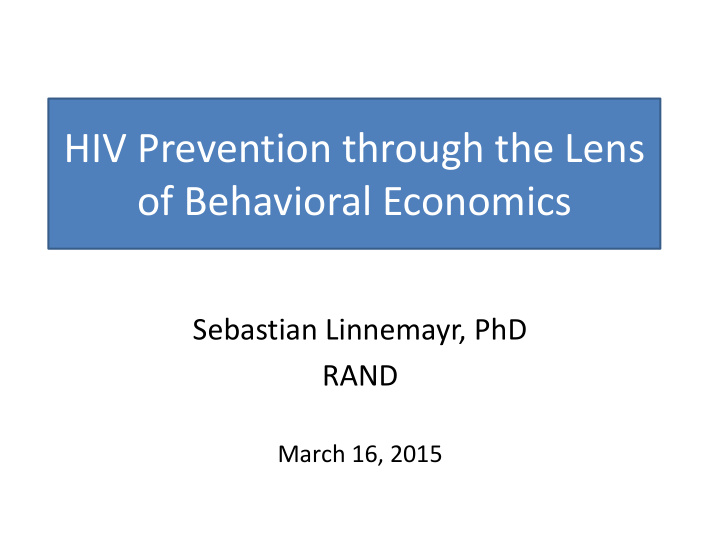



HIV Prevention through the Lens of Behavioral Economics Sebastian Linnemayr, PhD RAND March 16, 2015
Brief Overview of the Talk • What is Behavioral Economics (BE)? – 2 min. – Slides on Microbicide use and BE on MTN website – Slides on BE and ART adherence on NIH Adherence Network Distinguished Speaker Series – Paper on BE and HIV Prevention in JAIDS (2015)
Brief Overview of the Talk • Increased recognition that – behavior matters – Incentives can influence behaviors • Many people’s reactions (probably): Incentives don’t work… • But: BE points out other ways of – Influencing behavior (message framing, increasing the salience of decisions, …) – incentivizing!
Brief Overview of the Talk • Increased recognition that – behavior matters – Incentives can influence behaviors • Many people’s reactions (probably): Incentives don’t work… • But: BE points out other ways of – Influencing behavior (message framing, increasing the salience of decisions, …) – Structuring incentives
Main Question of the Talk How can we use BE to design better incentives?
Business as usual… • Much of policy is explicitly or implicitly based on the ‘rational actor’ of traditional (neoclassical) economics • Therefore, interventions typically focus on – Information provision (“Smoking is bad for you”) – Cash payments (“If you do X I pay you Y” )
What incentives have been used to improve HIV- related outcomes? • Pettifor et al. (2006): 16 studies using cash and financial incentives for HIV prevention • Galárraga (2013): 4 studies for improving ART adherence; 2 cash, 2 vouchers based • HPTN065: cash incentives did not have (fully) desired effect
What is behavioral economics? • Different from traditional economics that assumes that people “…can think like Albert Einstein, store as much memory as IBM’s Big Blue, and exercise the willpower of Mahatma Gandhi” (Thaler and Sunstein, 2008) • Studies BIASES (systematic decision-making errors): Present bias, Loss aversion, Salience, … • Uses these biases as entry points and levers to remedy the errors they cause
Business NOT as usual… • BE goes beyond this model, recognizes – our cognitive limitations (how we process statistics, for example) – our struggle with self-control
Business NOT as usual… • BE goes beyond this model, recognizes – our cognitive limitations (how we process statistics, for example) – our struggle with self-control
Business NOT as usual… • BE goes beyond this model, recognizes – our cognitive limitations (how we process statistics, for example) – our struggle with self-control
Business NOT as usual… • BE goes beyond this model, recognizes – our cognitive limitations (how we process statistics, for example) – our struggle with self-control – our desire to fit in with our peer groups – allows implementing smarter incentives (more effectively, at lower cost)
Traditional incentives Policies based on traditional economics: HOW MUCH?
BE and incentives Traditional economics: HOW MUCH? Behavioral economics: HOW?
Incentives: Traditional vs. BE Traditional Economics Behavioral Economics Dealing with Overrides preferences Supports individual's preferences preferences Nudges towards those of the rational, ‘cool’ self ‘Angel’ (Dec 31) vs. Devil (Jan 1) Type of Money (Can backfire!) incentive In-kind Chance to be kind (self-identity) Social prestige (“Employee of the month”) … Allocation Fixed (Quid pro quo) Contingent mechanism Unconditional Fixed Variable (Lotteries, raffles, …) Delivery Does not matter As a loss avoided (loss aversion) As a separate payment (salience)
Take-home message • Incentives are not only $$$ • Financial payments can backfire • BE can help us think of more effective incentives Example of an ongoing BE-based incentive program: – Trying to increase ART adherence in Uganda – Costs about 2 USD per person per year – Giving out small prizes (coffee mug, umbrella) through a raffle
BE incentives: 8% points increase in adherence R34 MH096609 (PI: Linnemayr )
Acknowledgments • MTN for invitation • NIMH for funding of the RAP study • Study participants and Staff
THANK YOU! slinnema@rand.org
Recommend
More recommend